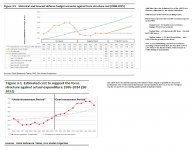- Reaction score
- 9,904
- Points
- 1,360
Eye In The Sky said:BUT...if the people HB is speaking about cutting was taken, as much as possible, from trimming the fat off the meat, maybe you could go up to 3, possibly 4 crews. Consider how much of the pay budget is chewed up by the fat year after year. Cpls are far less expensive than surplus CWOs, Snr Officers and GOFOs.
I know, we are already an embarrassingly small military but the message has come across loud and clear if this government is going to bump up defence spending (nope! and no one should be surprised...the overall Canadian population likes things like the Snowbirds and CAF members on parade in DEU on Nov 11th...and then it starts to peter off support-wise).
If funding is not going up, what option based on reality is there to consider?
See post I made here:
Humphrey Bogart said:Ladies & Gentlemen,
In March 2015, The Parliamentary Budget Office published a report titled “Fiscal Sustainability of Canada’s National Defence Program”.
Link to document provided:
http://www.google.ca/url?sa=t&rct=j&q=&esrc=s&source=web&cd=5&cad=rja&uact=8&ved=0ahUKEwiauoW05uzSAhVMzIMKHUmnAEAQFgg1MAQ&url=http%3A%2F%2Fwww.pbo-dpb.gc.ca%2Ffiles%2Ffiles%2FDefence_Analysis_EN.pdf&usg=AFQjCNHclg1rlehU0cXYrco9lLrlI1pJsg&sig2=QsrC6u_G9xcIbrHzUa99OA
The document highlights, in succinct detail, what exactly the problems are with respect to Canada’s current National Defence Program. I’ll give you the conclusion of the document to save you some reading:
“As a result of the underinvestment through the 1990s, the model illustrates the cumulative affordability gap that existed until the early 2000s. The model shows that it was only with the significant spending increases seen in the latter half of the 2000s that the affordability gap was closed and capability was able to be maintained and to some extent re-built. However, the recent cuts to the defence budget point to an impending affordability gap beginning in this fiscal year.
The outcomes of a fiscal gap in the defence program are beyond the scope of this paper. However, if program costs and the budget allocation are not brought to equilibrium, there will be a reduction in the capabilities of the current force structure. This means a reduction in the numbers and types of equipment and potentially a reduction in the number of personnel in the Armed Forces42. This would also result in the government falling short of its CFDS commitments.
Ultimately, it is the role of policy makers to decide on the future role of the defence program, the makeup of the force structure to support that role, and the budgetary allocation required to support that force structure.”
I’ve also uploaded a couple of charts which show the current predicament we’re in and also explain how we got there. If you read the document and look at Fig 3-6 in the document, you’ll note that the only way to afford our military is to revert to a 1997 Force Structure Calibration, which is the historic low point in our Defence Expenditure.
One of two things needs to happen:v
1. We drastically increase the Defence Budget; or
2. We make significant adjustments to our present Force Structure by cutting personnel, equipment, operations, etc. No more doing more with less, the future is all about doing less with less.
I'll reattach the graphic:
BLUF, current force structure is unaffordable with our current funding. Do you want good kit with lots of time to use it or do you want no kit with excess amount of folks sitting around twiddling their thumbs?
We can make all sorts of emotional arguments about how important certain folks, rice bowls, pieces of kit, etc. are. The thing I love about numbers is they don't lie and they're worth a heck of a lot more coming from the PBO than some internally produced document.
Parliamentary Budget Officer: The mandate of the Parliamentary Budget Officer (PBO) is to provide independent analysis to Parliament on the state of the nation’s finances, the government’s estimates and trends in the national economy; and upon request from a committee or parliamentarian, to estimate the financial cost of any proposal for matters over which Parliament has jurisdiction.








